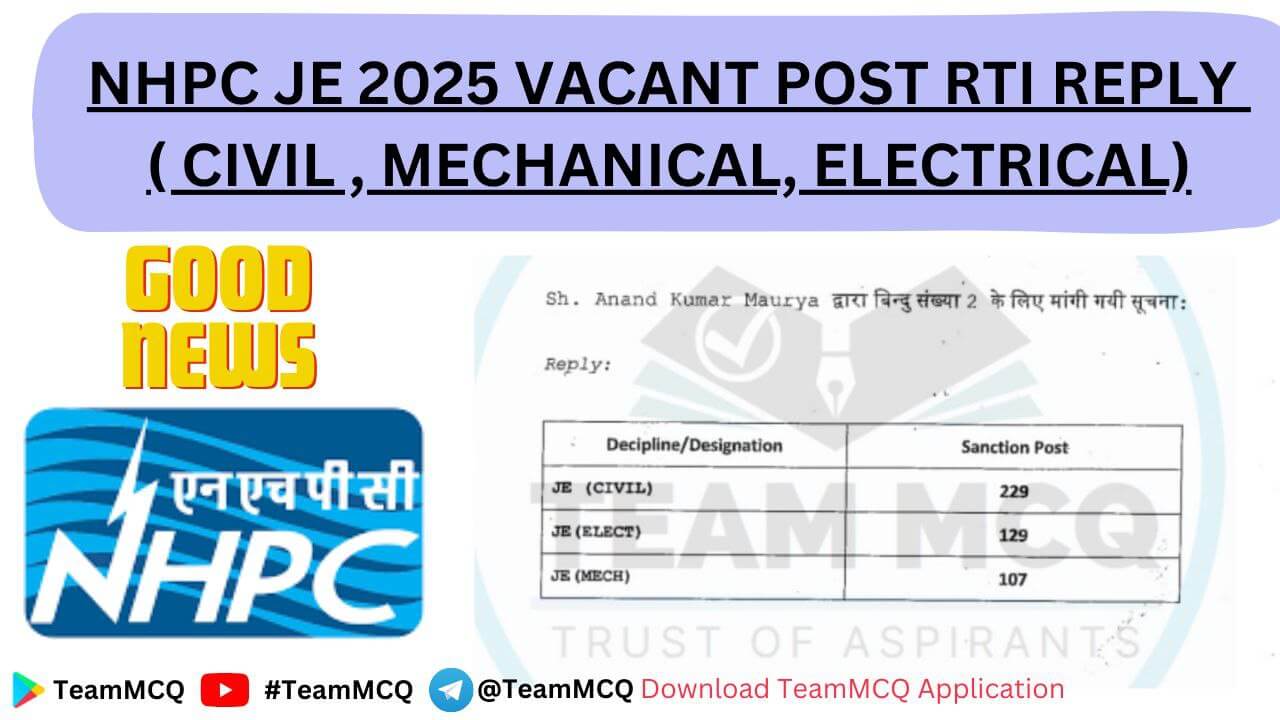From the elegance of Bharatanatyam to the vibrant beats of Bihu, classical and folk dances of India reflect centuries of cultural brilliance. Explore how each movement, rhythm, and costume tells a story of tradition, spirituality, and celebration.
Introduction: The Soulful Steps of India
Dance in India is more than movement — it is devotion, storytelling, resistance, and celebration all in one. From temple sanctuaries echoing with the grace of classical forms to village squares erupting with vibrant folk rhythms, classical and folk dances of India form the heartbeat of the nation’s cultural identity. Rooted in ancient scriptures, seasonal festivities, and regional pride, each dance form reflects a unique narrative — a convergence of rhythm, costume, gesture, and music. While classical dances of India are often linked to spirituality and performed on revered stages, folk dances of India emerge from the earth itself — joyous expressions of the people, often passed down through generations.
Together, these dances are more than art — they are living heritage, shaping how India celebrates life, honours the divine, and unites diverse traditions under a single cultural rhythm. This journey through the classical and folk dances of India will uncover not just steps, but centuries of story, soul, and sacred expression.
| Dance Form | Type | State of Origin | Key Features |
|---|---|---|---|
| Bharatanatyam | Classical | Tamil Nadu | Devotional themes, fixed upper torso, mudras |
| Kathak | Classical | Uttar Pradesh | Storytelling with rhythmic footwork, spins |
| Kathakali | Classical | Kerala | Elaborate costumes, facial expressions, mythology |
| Odissi | Classical | Odisha | Sculptural poses, lyrical grace, temple dance |
| Kuchipudi | Classical | Andhra Pradesh | Dramatic narrative, fast rhythmic footwork |
| Manipuri | Classical | Manipur | Soft movements, Raslila themes |
| Mohiniyattam | Classical | Kerala | Feminine grace, solo recital, swaying movements |
| Bhangra | Folk | Punjab | High-energy, harvest dance, upbeat music |
| Garba | Folk | Gujarat | Circular formations, Navratri celebrations |
| Ghoomar | Folk | Rajasthan | Graceful pirouettes, flowing skirts |
| Lavani | Folk | Maharashtra | Powerful rhythms, expressive gestures |
| Bihu | Folk | Assam | Joyful, springtime celebration |
| Chhau | Folk/Classical | Odisha, Jharkhand, WB | Martial arts influence, masks, dramatic storytelling |
| Yakshagana | Folk/Classical | Karnataka | Folk theatre style, mythological stories |
Roots of Rhythm: The Cultural Significance of Classical and Folk Dances of India
India’s dance heritage is one of the most vibrant and expressive elements of its cultural identity. Dance here is not just performance — it’s storytelling, worship, history, and celebration all rolled into one. Across centuries, from sacred temples to rural grounds and global stages, the classical and folk dances of India have embodied the spirit of the nation’s diversity and unity.
Classical dances like Bharatanatyam, Kathak, Odissi, and Kuchipudi are rooted in ancient texts such as the Natya Shastra. These dance forms blend movement, expression (abhinaya), and rhythm to depict mythological stories and spiritual devotion. Each movement is precise, carrying deep symbolism and centuries of tradition. These forms were often performed in temples as acts of devotion, making them spiritually rich and disciplined.

In contrast, folk dances of India like Bihu, Garba, Bhangra, and Ghoomar are more spontaneous and festive. They reflect everyday life, agricultural cycles, and community values. Typically performed during festivals, harvests, and local fairs, folk dances are lively, colorful, and full of raw energy. They are passed down through generations as a form of shared tradition.
Together, the classical and folk dances of India showcase the country’s rich cultural layers — where devotion meets joy, and tradition embraces innovation. Every beat, gesture, and costume tells a story of India’s living heritage, connecting the past to the present in one graceful rhythm.
Bharatanatyam to Kathak: Classical Dances of India That Transcend Time
The classical and folk dances of India are windows into the soul of its ancient traditions. Among the classical styles, a few stand tall for their history, storytelling power, and grace.
Bharatanatyam, one of the oldest classical dances, originated in Tamil Nadu. It was traditionally performed by temple dancers (devadasis) as an offering to the divine. Known for its fixed upper torso, bent legs, intricate footwork, and expressive hand gestures (mudras), Bharatanatyam tells epic stories from the Ramayana and Mahabharata. Today, it graces both temples and international stages with its timeless charm.
Kathak, from northern India, blends dance and drama. Derived from the Sanskrit word katha (story), it was once performed by bards who narrated mythological tales. Under the Mughal influence, Kathak evolved into a courtly art, gaining intricate spins, rhythmic footwork, and a blend of Hindu-Muslim aesthetics. The accompanying tabla and ghungroos (ankle bells) create an unforgettable rhythmic experience.

Odissi, from Odisha, is fluid and lyrical, often described as “sculpture in motion.” With its graceful curves, torso movements, and spiritual themes, Odissi reflects both devotion and elegance. It draws heavily from temple sculpture and devotional poetry.
Other iconic classical forms include Kuchipudi, Mohiniyattam, Manipuri, and Sattriya—each rooted in a specific region, with its own unique expressions and musical traditions.
These classical forms are not relics of the past—they continue to evolve, educate, and enchant, forming the spiritual core of the classical and folk dances of India.
Colors of the People: Folk Dances That Celebrate Life and Heritage
From snow-capped mountains to sun-drenched coasts, the Classical and Folk Dances of India reflect the heartbeat of the nation—vibrant, expressive, and rooted in tradition. While classical forms follow strict rules, folk dances are spontaneous celebrations of life, shaped by regional customs, rituals, and festivals.
Performed during harvests, weddings, and local festivals, these dances express the spirit of the community. In Punjab, the powerful rhythms of Bhangra and graceful moves of Gidda capture the energy of agricultural life. In Gujarat, people dance Garba and Dandiya Raas during Navratri, honoring feminine divinity with rhythmic joy. The eastern states bring stories to life through Chhau, a folk-martial dance rich with masks and mythology. Down south, Karakattam pays tribute to the rain gods with balancing acts and swift footwork.
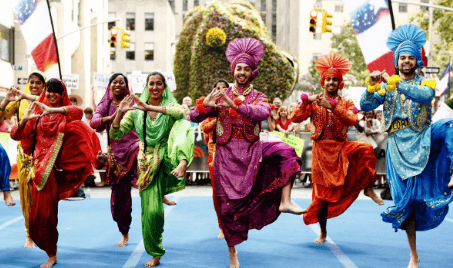

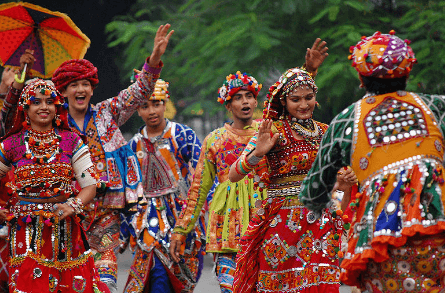
The Classical and Folk Dances of India are inseparable from the sounds of traditional instruments like the dhol, nagara, and shehnai, and the visuals of colorful costumes that mirror each region’s culture and landscape.
Even in today’s fast-paced world, these dances continue to thrive in cultural festivals and schools, and even go global. They are more than performances—they are living stories that carry forward the soul of Indian tradition, joyfully shared across generations.
Regional Wonders: State-Wise Classical and Folk Dances of India
India’s diversity shines brightest through its arts, especially in the Classical and Folk Dances of India, which vary beautifully across states. Each region has its own rhythm, attire, and storytelling method, offering a window into its cultural soul.
In Tamil Nadu, the classical dance Bharatanatyam is a blend of precise footwork and spiritual expression. Meanwhile, in Kerala, Kathakali dazzles with elaborate makeup and dramatic storytelling, while Mohiniyattam offers graceful, feminine charm. Odisha is home to Odissi, one of the oldest surviving classical forms known for its temple origins and fluid torso movements.
The northern plains bring the rhythmic spin of Kathak, popular in Uttar Pradesh and Rajasthan, often telling mythological tales through movement and facial expressions. In the northeast, Sattriya from Assam blends drama and devotion, originating from Vaishnavite monasteries.
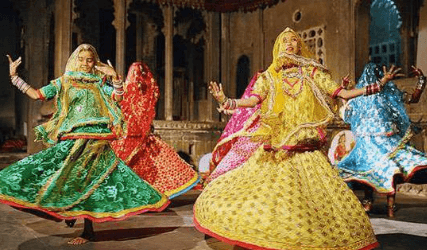
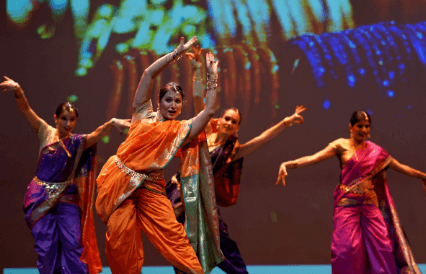
When it comes to folk dances, Ghoomar from Rajasthan, Lavani from Maharashtra, and Bihu from Assam showcase local traditions, seasonal celebrations, and community spirit. Each folk style is unique in its pace, music, and purpose—whether it’s to thank nature, celebrate life, or mark social unity.
The Classical and Folk Dances of India are more than just art forms—they are living traditions that define regional identity and pride. Knowing them state by state is like reading a colorful cultural map of India in motion.Regional Wonders: State-Wise Classical and Folk Dances of India.
Festivals, Rituals, and Stories: The Spiritual Essence of Indian Dance
The Classical and Folk Dances of India are not just performances; they are spiritual expressions rooted in centuries-old traditions. Across the country, dance serves as a sacred language to celebrate deities, narrate epics, and mark life’s most meaningful moments.
Many classical dance forms originated in temples, performed as offerings to gods and goddesses. Bharatanatyam, for instance, was once performed by devadasis in Tamil temples, while Odissi evolved as a form of ritual worship in Odisha’s Jagannath temples. These dances blend storytelling (abhinaya) and rhythm (nritta) to express devotion, myth, and philosophy.
Folk dances, too, are deeply connected with festivals and seasonal rituals. During Navratri, Gujarat comes alive with Garba and Dandiya Raas, while Bhangra in Punjab celebrates the harvest festival of Vaisakhi with energetic beats. In Kerala, Theyyam is not just a folk performance but a powerful ritual where dancers are believed to embody divine spirits.
Through these sacred stories and celebrations, the Classical and Folk Dances of India reflect the deep connection between the spiritual and the cultural. Whether it’s invoking gods or rejoicing with the community, dance is a medium of both devotion and joy—uniting people through movement and meaning.
Costumes, Music, and Mudras: The Language of Indian Dance
The soul of the Classical and Folk Dances of India lies not just in movement but in every thread of fabric, every note of music, and every gesture performed on stage. These dances speak a language of their own—one that uses costumes, instruments, and mudras (hand gestures) to communicate stories, emotions, and cultural memory.
In classical dances, the costume is more than attire—it’s tradition woven into silk, gold, and color. For instance, Bharatanatyam dancers wear pleated sarees with temple jewelry and elaborate hairdos adorned with flowers. Kathak performers don flowing anarkalis that swirl with their spins, accompanied by ghungroos (ankle bells) that add rhythm to every movement. Each classical form has its unique visual aesthetic, perfectly synchronized with its region, history, and themes.
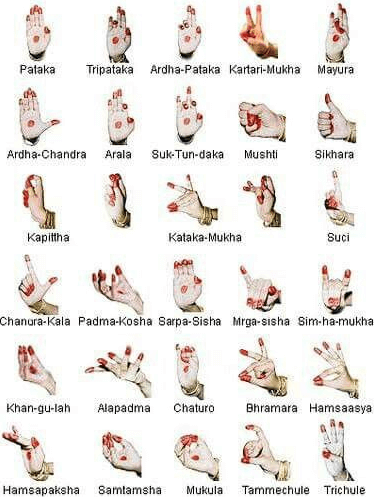
Music plays a foundational role. The Classical and Folk Dances of India are often performed to live music, combining instruments like the mridangam, tabla, nattuvangam, and flute. In folk performances, traditional drums, wind instruments, and claps guide dancers in rhythmic harmony with the earth.
The most profound element, however, is the mudra. These hand gestures, codified in ancient texts like the Natya Shastra, are used to narrate entire epics. A single movement of fingers can represent a lotus blooming, a bird flying, or a god’s blessing.
In folk dances, the language is raw and expressive. Costumes burst with color—mirrors, embroidery, turbans, and skirts reflect regional identity. Music is often loud, lively, and community-driven, and gestures are intuitive rather than codified.
Together, these elements create a visual symphony. The Classical and Folk Dances of India don’t merely entertain—they express, embody, and enchant.
Revival and Reinvention: The Future of Classical and Folk Dances of India
The Classical and Folk Dances of India have withstood the test of time, but their survival hasn’t been effortless. As India moved through colonization, globalization, and modernization, many dance forms faced neglect or near extinction. Yet, in recent decades, there’s been a heartening wave of revival, reinvention, and renewed pride in cultural roots.
Post-independence India saw the first major revival efforts. In the 1950s and 60s, artists like Rukmini Devi Arundale (Bharatanatyam), Birju Maharaj (Kathak), and Kelucharan Mohapatra (Odissi) began to reintroduce classical dance into public consciousness and cultural institutions. This period marked the formalization of dance academies, curriculum, and national recognition.

Government initiatives like the Sangeet Natak Akademi (est. 1953) and Zonal Cultural Centres have preserved traditional art forms through documentation, grants, and festivals. Folk dances such as Bihu, Garba, and Ghoomar have also received support via state-sponsored events and school programs.
In the 21st century, digital platforms have become powerful tools for reinvention. Classical performances are now streamed online, folk dancers share reels on social media, and global audiences are tuning in. Shows like India’s Got Talent and cultural fests abroad have given dancers massive visibility, turning once-local art into international sensation.
Young dancers are experimenting with fusion choreography—combining Bharatanatyam with hip-hop, or Bhangra with EDM beats. While purists debate authenticity, this creative blend ensures the Classical and Folk Dances of India stay alive, relevant, and thrilling to new audiences.
Why is this important? Because dance is more than art—it’s identity. Reviving these traditions safeguards intangible heritage and fosters pride in India’s diverse cultures. The National Education Policy (2020) has also emphasized integrating arts into the school curriculum, giving hope that future generations won’t just learn dance—they’ll live it.
The future of the Classical and Folk Dances of India lies in respectful innovation—where tradition is not lost, but lovingly transformed.
From Local Stages to Global Spotlights: Indian Dance on the World Map
The Classical and Folk Dances of India have moved far beyond temple courtyards and village squares. Today, they dazzle on global stages—from Broadway and the Sydney Opera House to international dance festivals and viral social media platforms. What was once confined to regional performances now radiates worldwide as a symbol of India’s vibrant cultural identity.
Icons like Uday Shankar were among the first to introduce Indian classical dance to the West in the early 20th century. His pioneering performances in Europe and America paved the way for global appreciation of Bharatanatyam, Kathak, and Odissi. In more recent times, artists such as Mallika Sarabhai, Astad Deboo, and Alarmél Valli have taken Indian dance to international festivals, blending traditional forms with contemporary narratives.

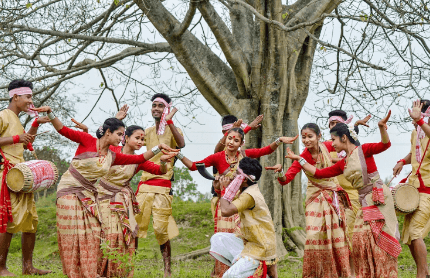
Folk dances too have found a huge audience abroad. Bhangra, Ghoomar, and Garba are now common in cultural shows across the US, UK, and Canada—especially among the Indian diaspora. Events like Navratri Nights in London or Baisakhi Parades in New York showcase Indian folk traditions with pride and grandeur.
Bollywood has also played a massive role in taking the Classical and Folk Dances of India global. From the Oscars to Olympic ceremonies, Indian dance has become a cultural ambassador. Even global artists like Beyoncé, Coldplay, and Shakira have drawn inspiration from Indian movement styles in their music videos.
Institutions such as Kalakshetra, Nrityagram, and Kathak Kendra have trained generations of dancers, many of whom now teach abroad, ensuring the traditions continue across continents. Meanwhile, social media has become a game-changer—allowing young dancers from India and beyond to share their performances with millions through platforms like Instagram, YouTube, and TikTok.
The Classical and Folk Dances of India are no longer bound by geography. They have become a language of identity, resilience, and joy for Indians everywhere—and a rich, rhythmic invitation to the rest of the world.
Conclusion: The Living Legacy of Indian Dance
The Classical and Folk Dances of India are more than artistic expressions—they are living traditions that pulse with history, spirituality, and community. From the sacred halls of temples to vibrant village gatherings, and now onto global stages, these dances have evolved without losing their soul.
Each classical form like Bharatanatyam, Kathak, Odissi, and Manipuri carries centuries of discipline, devotion, and storytelling. Meanwhile, folk dances like Bihu, Garba, and Ghoomar celebrate everyday life, joy, harvests, and the human connection to nature and ritual.
Together, they showcase India’s unmatched cultural diversity. Whether performed in intricate temple rituals, during colorful festivals, or on the world’s biggest platforms, the Classical and Folk Dances of India continue to inspire, empower, and unite. They are not just performances—they are India in motion.
As India balances tradition and innovation, these dance forms remind us that our cultural heritage is a powerful force, always evolving, always relevant, and always magical.
MCQ QUESTIONS WITH EXPLANATION
1. Which is considered the oldest classical dance form of India?
A. Kathak
B. Bharatanatyam
C. Odissi
D. Kuchipudi
✅ Correct Answer: B. Bharatanatyam
📝 Explanation:
Bharatanatyam is regarded as the oldest classical dance form of India, with roots tracing back over 2,000 years to temple dances in Tamil Nadu. It was performed by Devadasis as a spiritual offering in temples.
2. The Bihu dance, a vibrant folk dance form, originates from which Indian state?
A. Manipur
B. Assam
C. Odisha
D. Sikkim
✅ Correct Answer: B. Assam
📝 Explanation:
Bihu is a joyful folk dance from Assam, performed during the Rongali Bihu festival to celebrate spring and the Assamese New Year. It reflects themes of love, fertility, and nature.
3. In which year was Sattriya officially recognized as a classical dance by the Sangeet Natak Akademi?
A. 1956
B. 1995
C. 2000
D. 1965
✅ Correct Answer: C. 2000
📝 Explanation:
Sattriya, originating from Assam and created by Srimanta Sankardev, was declared a classical dance in 2000. It combines drama, music, and storytelling, and is rooted in Vaishnavite monasteries called Satras.
4. Which classical dance form prominently features the use of facial expressions (abhinaya) and elaborate costumes to enact mythological themes?
A. Mohiniyattam
B. Kathakali
C. Manipuri
D. Yakshagana
✅ Correct Answer: B. Kathakali
📝 Explanation:
Kathakali, from Kerala, is known for its dramatic storytelling using abhinaya (expressions), intricate hand gestures, and vibrant makeup and costumes. The performances often depict stories from the Mahabharata and Ramayana.
5. Lavani, known for its energetic rhythm and sensual expressions, is a folk dance from which region?
A. Punjab
B. Rajasthan
C. Maharashtra
D. Gujarat
✅ Correct Answer: C. Maharashtra
📝 Explanation:
Lavani is a traditional folk dance of Maharashtra, often performed to the beat of the dholki. It combines music and dance to convey stories of love, politics, and social issues, especially during the 18th and 19th centuries under Maratha rule.



